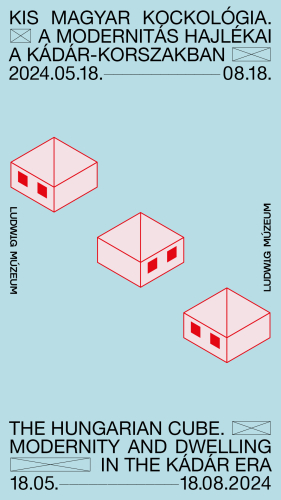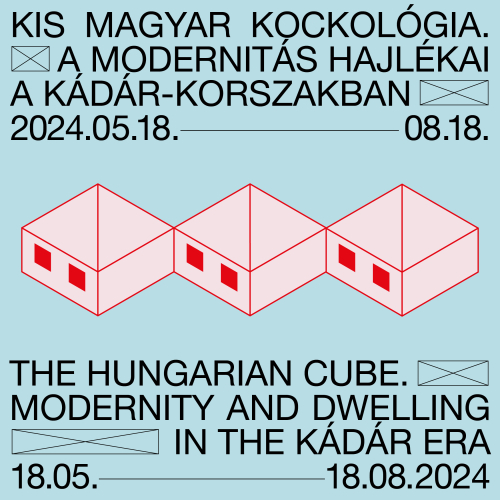The fundamental idea of the exhibition is to explore a familiar, almost everyday architectural phenomenon, the characteristic Hungarian “cube house” (a house with a hip roof, the so-called Kádár cube) as an expression of architectural modernization. The exhibition aims to present the origin, development, and impact of this house type in the history of Hungarian visual culture through various artistic media and immersive installations.
The typical family house of the 1960s and 70s still defines the appearance of Hungarian rural settlements to this day. This much-maligned “stepchild” of post-war Hungarian socialist architecture turned out to be one of the most enduring architectural forms of the last century. Regardless of our relationship with the cube house, it is part of our built cultural heritage. The exhibition aims to showcase the cultural context and genealogy of one of the defining architectural forms of 20th-century Hungary. As a medium for private, self-built construction and an architectural manifestation of modernization, the cube house was a spontaneous response of vernacular architecture to the societal demands for housing. Over a span of approximately two decades – from the late 1950s to the late 1970s – the typology of rural Hungarian houses remained a
significant local and influential factor in our region until the dominance of the next house type (Alpine house) emerged.
The aim of the exhibition is to show the cultural context and genealogy of one of the most grassroots, defining forms of 20th century Hungarian architecture. Interpreting the specific aesthetics of the house type as a kind of language, understanding its semantics, and explaining its hidden meanings, is the backbone of the exhibition, which seeks answers to questions such as: what does the cube house, which appears in the common space of cultural memory, mean for us? What should we do with it, what is its perception: positive or negative? Where does the house type originate from and how did it spread in Hungary, what are the geographical boundaries and iconographic characteristics of its appearance? What was the purpose of the individualisation, ornamental or surface modification of the facades of the houses? What were the psychological and sociological, cultural anthropological components of the spread of the house type? etc. The exhibition focuses on interpreting the unique aesthetics of this house type as a kind of language, understanding its semantics, and unfolding its hidden meanings and seeks answers to a number of questions; What does the cube house in the common cultural memory space mean for us? What should we do with it, how should we perceive it: positively or negatively? Where did this type of house come from and how did it spread, what are its geographical limits and iconographic characteristics? What was the purpose of the individual design of the façades of the houses, the ornamental transformation of the surface? What were the psychological, sociological and cultural anthropological components of the spread of the house type?
The exhibition will mainly feature works by contemporary artists with a cube house theme. Many of the works were originally created in different contexts and have different focuses, but in the context of the exhibition they reveal a number of important, albeit different, details. Factors that seem insignificant, specific time capsules that, in the original context of the works, fell to the periphery of the gaze – and the consciousness – and thus remained largely hidden. The exhibition, as intended, attempts to reinterpret and connect the givens of the past with the issues of the present, while looking at a dominant cultural pattern in a different way.
The exhibition is open: 18 May – 18 August 2024
Curator: KÉSZMAN József
Assistant-curator: MAJ Ajna, MÁTÉ Zsófia
Exhibiting Artists
ASZTALOS Zsolt, BIRKÁS Ákos, BME Építész Szakkollégium (KUSTRA Vencel, RÉVÉSZ Tamás, PARAGI András) és SZEDERKÉNYI Lukács (au műhely), BUKTA Imre, CSIZIK Balázs, CSONDOR Réka, FEHÉR László, GERHES Gábor, HÉZSŐ Ferenc, KERESZTESI Botond, KIRÁLY András, Magyar Malter, MERÉNYI Dávid, NEMES Csaba, Oláh Mara OMARA, RAJK László, Katharina ROTERS, SCHMIED Andi, SIBITKA Anna, SZOLNOKI József, SZÖLLŐSI Géza, tekerd! csoport
Lending Institutions, Galleries and Collections
Magyar Fotográfiai Múzeum; Sárospataki Képtár; Szépművészeti Múzeum – Magyar Nemzeti Galéria; Birkás Ákos Művészeti Alapítvány; Einspach Fine Art & Photography; Longtermhandstand; Molnár Ani Galéria; Vintage Galéria; Borsó és Kacsa magángyűjtemény, Budapest; Everybody Needs Art, magángyűjtemény, Budapest; Oliver Hont Collection, Athens/Budapest; private collection





























